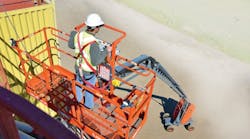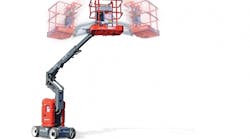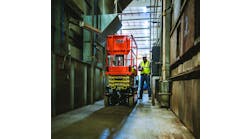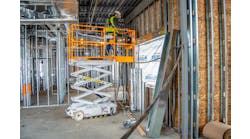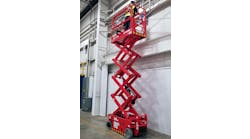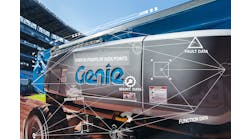RER interviews Skyjack’s vice president of marketing about new developments in AWPs, ANSI and ISO standards, Skyjack’s Easydrive and Skyriser features, and more.
RER: What are the most important technological developments in aerial work platforms in the past year or so?
Early: There are two things worthy of mention. First: manufacturers’ responses to regulatory demands including those covering emissions. Although on the face of it the customer does not see a direct benefit (e.g. in terms of rental rates), the manufacturer is faced with a number of challenges to meet the demands in a cost effective way. So although maybe there are a few things that “stand out” there is great deal of system optimization that goes on behind the scenes.
Secondly, the desire for scissorlifts with greater platform and working heights that means scissor stack designs need to accommodate this need. Skyjacks SJ 4740 with a 45-foot working height is a case in point.
What do you expect in the coming year?
The main thing on the horizon is the imminent new ANSI standard which will change the way manufacturers design and test AWPs. Ultimately of course the same standard will mean that the day-to-day operation of an AWP will alter. For example the introduction of load sensing means AWP capacities are physically controlled.
What are the most compelling developments in the low-level access area? Is this a growing market segment?
A lot depends on definition here. Arguably it may include up to 19- or 12-foot platform height. In that case The SJ3219 represents the best-selling scissor globally. In addition we have seen success with the SJ12 and SJ16 vertical mast lifts.
To many it focuses on a new series of even smaller machines that include low weight as one of their characteristics. These certainly have a place, but the key to their success is the degree to which they are robust enough to operate in the rental industry and provide low cost of ownership.
What is likely to be new at the 60, 80, 100 foot level?
The SJ86T represents our tallest boom. In the next few years we will look at the 125- to 135-foot category, both in telescopic and articulating format.
Sum up what your company has done technologically recently that is unique?
The Skyjack boom range boasts a number “firsts”:
EASYDRIVE - A unique boom feature only utilized by Skyjack- the boomlift drive function operates in accordance with the general orientation of the turret’s counterweight over the chassis (i.e. joystick forward=counterweight facing forward). This provides intuitive operation by allowing the unit to move in the general direction of the joystick’s movement.
SKYRISER - A unique feature found on Skyjack’s articulating boomlift. It ensures that the riser and main pivot point connecting the fly boom to the riser travel in a straight vertical line. Movement in a true vertical manner, without drifting forward or back, reduces the amount of repositioning the operator needs to do in order to stay close to a building façade.
AXLDRIVE – This gives positive traction and excellent rough ground “terrain-ability.” This is achieved using an automatic locking differential on the back axle and non-spin and limited slip front differential on the front axle. This means machines can climb grades of up to 30 percent in the case of rough terrain scissorslifts, 45 percent in the case of articulating boomlifts and 50 percent in the case of telescopic boomlifts. This industry leading terrain capability means one can use the Skyjack rough terrain scissorlifts and boomlifts in the most challenging of conditions.
We have seen tremendous growth in the AWP segment. Still I’m sure there are some industries that are open for growth, and geographic regions where there is ample room for adoption of AWPs. What are some of your thoughts about this?
On a global scale the AWP market has pockets such as Asia and the subcontinent that show great potential. If China successfully develops the rental concept and that in turn includes AWPs then it has a potential equivalent to or greater than North America.
The main focus for Skyjack is to supply the rental industry. Having said that, the rental industry itself will be able to take advantage by looking at industries that can grow in terms of AWP use. I think one area that will promote this growth is the availability of accessories designed to achieve some of the specific tasks that face those industries. As these come on stream, the ‘older practices’ can be replaced with something more efficient.
There have been great advances in safety in the aerial industry. What are some concerns in the safety arena?
I hesitate to call it a concern. A number of organizations have been involved in aspects of safety: construction companies, government bodies, trade associations and manufacturers. To effectively focus these valuable sources of information and experience we need to ensure that efforts are coordinated. Otherwise we may have a series of recommendations that could contradict each other. A good example of correct approach is the concerted industry effort to develop a new ISO standard regarding controls standardization.
